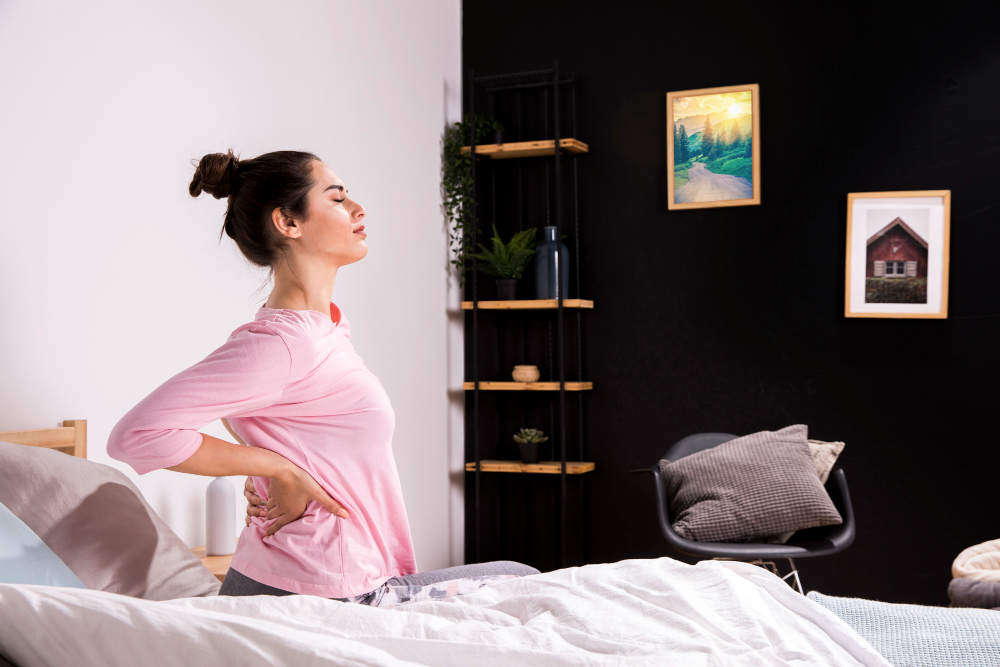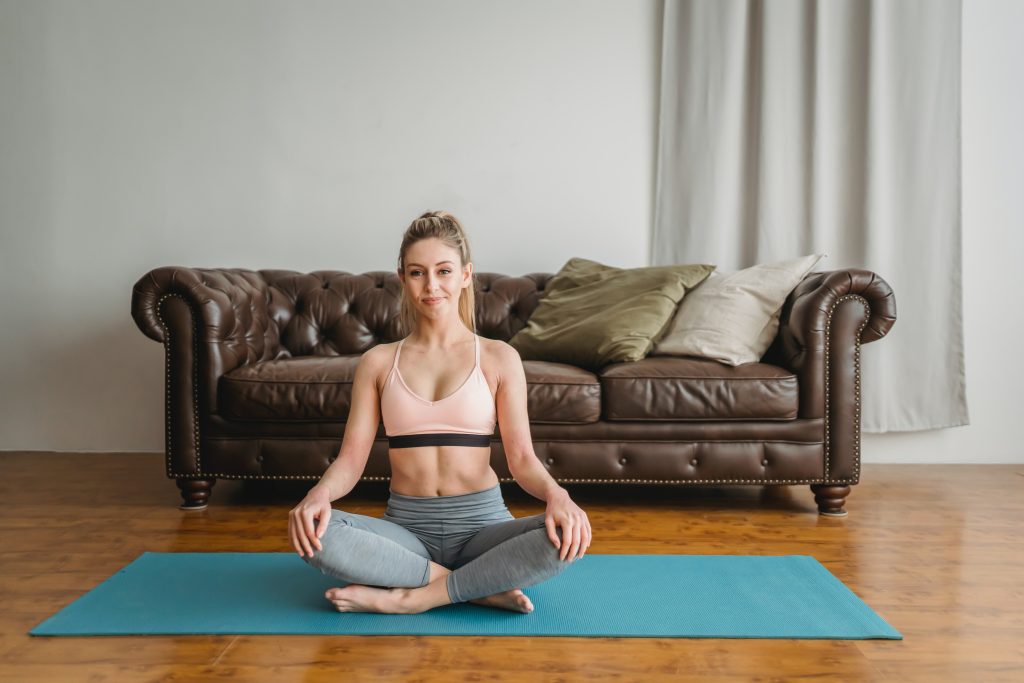Discover effective at-home physical therapy exercises to alleviate postpartum back pain.
At-Home Physical Therapy Exercises for Postpartum Back Pain
Being a new mom is an incredible experience, full of joy and excitement. But along with the joys of motherhood often come aches and pains, particularly in the back. Postpartum back pain is a common complaint among new mothers, but the good news is that there are ways to alleviate it. In this article, we will explore the causes of postpartum back pain, the role of physical therapy in alleviating it, and essential at-home exercises that can help you find relief. So let’s dive in and say goodbye to back pain!
Understanding Postpartum Back Pain

Before we get into the specifics of how to address postpartum back pain, it’s important to understand what causes it. Pregnancy and childbirth can take a toll on your body, including your back. The added weight and pressure on your spine during pregnancy, as well as hormonal changes, can contribute to back pain after giving birth.
While postpartum back pain is natural and common, it’s essential to address it promptly to avoid long-term discomfort. And that’s where physical therapy comes in!
Physical therapy is a non-invasive and effective way to treat postpartum back pain. It focuses on strengthening the muscles in your back, abdomen, and pelvis, improving your posture, and relieving muscle tension. By working with a physical therapist, you can develop a personalized treatment plan that targets your specific needs and helps you regain your strength and mobility.
Causes of Postpartum Back Pain
Postpartum back pain can be caused by a variety of factors. Some of the common culprits include:
- Abdominal muscle separation (diastasis recti)
During pregnancy, the growing baby puts pressure on your abdominal muscles, causing them to stretch and separate. This condition, known as diastasis recti, can weaken your core and contribute to back pain.
- Poor posture during pregnancy and while breastfeeding
As your belly grows during pregnancy, it’s common to adopt a forward-leaning posture to compensate for the extra weight. This poor posture can strain your back muscles and lead to pain. Additionally, while breastfeeding, many women hunch over to support their baby, further exacerbating back pain.
- Weakened core and pelvic floor muscles
Pregnancy and childbirth can weaken the muscles in your core and pelvic floor, which are essential for providing stability and support to your spine. When these muscles are weak, your back may bear the brunt of the workload, resulting in pain and discomfort.
- Stress-related muscle tension
The demands of being a new mom can be overwhelming, leading to stress and tension in your body. This tension can manifest as muscle tightness in your back, causing pain and discomfort.
Understanding the underlying causes of your back pain can help you tailor your physical therapy exercises for maximum effectiveness. By addressing these specific issues, you can alleviate pain and prevent future complications.
How Long Does Postpartum Back Pain Last?
Many new moms wonder how long they can expect their postpartum back pain to last. While every woman is different, most experience some level of discomfort for the first few months after giving birth. However, by implementing physical therapy exercises and proper self-care, you can speed up the healing process and find relief more quickly.
It’s important to note that postpartum back pain can persist for longer periods if left untreated or if there are underlying issues that require additional intervention. Therefore, seeking professional help from a physical therapist is crucial to ensure a proper diagnosis and effective treatment.
Physical therapy not only helps alleviate back pain but also promotes overall well-being and recovery after childbirth. It provides you with the tools and techniques to strengthen your body, improve your posture, and prevent future injuries.
Remember, taking care of yourself is essential as you navigate the joys and challenges of motherhood. By prioritizing your health and seeking appropriate treatment, you can enjoy this special time with your baby while minimizing discomfort and maximizing your physical well-being.
The Role of Physical Therapy in Alleviating Postpartum Back Pain
Physical therapy is a powerful tool for recovering from postpartum back pain. It can help you regain strength, improve flexibility, and correct any imbalances caused by pregnancy and childbirth. The journey of motherhood is a beautiful and transformative experience, but it can also take a toll on your body. The physical demands of pregnancy and the process of giving birth can lead to various musculoskeletal issues, including back pain.
Postpartum back pain is a common concern among new mothers. It can be caused by a combination of factors, such as hormonal changes, weakened muscles, and poor posture. The good news is that physical therapy offers a range of benefits that can effectively address and alleviate postpartum back pain.
Benefits of Physical Therapy for Postpartum Back Pain
Physical therapy can work wonders in helping you recover from postpartum back pain. Here are some of the fantastic benefits it offers:
- Strengthen your core and pelvic floor muscles: Pregnancy and childbirth can weaken these muscles, leading to instability and back pain. Physical therapy exercises can target and strengthen these areas, providing much-needed support for your spine.
- Improve your posture: During pregnancy, your growing belly can cause your center of gravity to shift, leading to poor posture. Physical therapy can help you regain proper alignment and posture, relieving strain on your back.
- Reduce muscle tension and inflammation: The physical stress of pregnancy and childbirth can cause muscle tension and inflammation, contributing to back pain. Physical therapy techniques such as massage, stretching, and manual therapy can help release tension and reduce inflammation, promoting pain relief.
- Enhance your overall mobility: Pregnancy can limit your range of motion, making everyday activities challenging. Physical therapy can help improve your flexibility and mobility, allowing you to move more freely and comfortably.
By working with a physical therapist, you can create a personalized plan to address your specific needs and goals. They will assess your condition, develop a tailored treatment program, and guide you through exercises and techniques that will gradually alleviate your postpartum back pain.
When to Start Physical Therapy After Childbirth
While it’s important to get ample rest and recover in the first few weeks after giving birth, you can start incorporating gentle physical therapy exercises as soon as you feel ready. Every woman’s postpartum recovery journey is unique, so it’s essential to listen to your body and consult with your healthcare provider or a physical therapist to ensure it’s safe for you to begin.
Remember, it’s okay to start slowly and gradually increase the intensity as you regain strength and mobility. Your physical therapist will guide you through the process, ensuring that you progress at a pace that is appropriate for your individual circumstances.
Postpartum back pain should not be ignored or accepted as a normal part of motherhood. With the help of physical therapy, you can find relief and regain your strength, allowing you to fully enjoy the joys of motherhood without the burden of back pain.
Essential At-Home Physical Therapy Exercises
One of the significant advantages of physical therapy is that you can continue your therapy at home. Here are some essential exercises that can provide relief for postpartum back pain:
Stretching Exercises for Postpartum Back Pain
Stretching is an excellent way to relieve muscle tension and promote flexibility. Try these simple stretches:
- Cat-Camel stretch: Get on all fours, arch your back upward like a cat, then lower it and extend your spine.
- Child’s pose: Sit on your heels, stretch your arms forward, and lower your upper body to the floor.
- Seated spinal twist: Sit with your legs crossed, twist your upper body to one side while placing your opposite arm on the outside of your thigh.
Perform these stretches gently, holding each position for 20-30 seconds. Remember to breathe deeply and listen to your body.
Strengthening Exercises for Postpartum Back Pain
Building strength in your core and back muscles is crucial for alleviating postpartum back pain. Here are a few strengthening exercises to get you started:
- Pelvic tilts: Lie on your back, bend your knees, and tilt your pelvis upward, engaging your core muscles.
- Bird dog exercise: Position yourself on all fours, extend one arm forward while simultaneously extending the opposite leg backward, engaging your core and back muscles.
- Bridge pose: Lie on your back, bend your knees, and lift your hips off the ground while engaging your core and glute muscles.
Start with a few repetitions of each exercise and gradually increase the number as your strength improves.
Safety Measures and Precautions
While physical therapy exercises are generally safe, it’s crucial to take some precautions to protect yourself from injury. Here’s what you need to keep in mind:
How to Safely Perform At-Home Physical Therapy Exercises
When doing your at-home physical therapy exercises, always remember these safety tips:
- Warm up before exercising to prepare your muscles.
- Start with gentle movements and progress at your own pace.
- Listen to your body and rest when needed.
- Ensure you have proper form and technique to avoid strain.
By following these safety measures, you can enjoy the benefits of physical therapy while minimizing the risk of injury.
Signs You Should Stop Exercising and Consult a Professional
While it’s essential to stay active and perform your exercises, it’s equally crucial to be aware of any warning signs that indicate you should stop exercising and seek professional guidance. These signs include:
- Increased or sharp pain
- Swelling in the affected area
- Persistent discomfort that does not improve with rest
If you experience any of these symptoms, it’s time to consult with a physical therapist or healthcare provider for further evaluation.
Maintaining Progress and Preventing Future Back Pain
To make lasting progress and prevent future back pain, it’s important to incorporate physical therapy exercises into your daily routine. Here’s how:

Incorporating Physical Therapy Exercises into Your Daily Routine
Consistency is key when it comes to physical therapy exercises. Here are a few tips to help you stay on track:
- Set aside dedicated times throughout the day for your exercises.
- Create a peaceful and comfortable exercise space.
- Involve your baby – they can be your workout buddy!
By weaving these exercises seamlessly into your daily routine, you’ll ensure that they become habits that promote improved back health.
Lifestyle Changes to Support Back Health Postpartum
While physical therapy exercises play a vital role in alleviating postpartum back pain, it’s equally essential to make some lifestyle changes to support your back health. Consider the following:
- Practice good posture throughout the day, especially when sitting and lifting.
- Avoid carrying heavy loads, and always use proper lifting techniques.
- Invest in a supportive mattress and pillow for a good night’s sleep.
With these lifestyle changes, you’ll provide your healing body with the care it deserves.
So there you have it – a comprehensive guide to at-home physical therapy exercises for postpartum back pain. By understanding the causes of your back pain, harnessing the power of physical therapy, and incorporating these exercises into your daily routine, you can say goodbye to discomfort and hello to a healthier, pain-free back. Remember to consult with a healthcare professional or physical therapist to ensure that these exercises are suitable for your specific needs. Happy healing!



